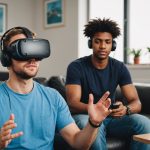Understanding Input Lag
Input lag is the delay between a command entry via a controller or keyboard and the corresponding action on screen. This delay can significantly influence gaming performance, especially in fast-paced or competitive gaming environments. High input lag can result in missed opportunities or actions not registering in time.
The central factor affecting input lag is latency issues, which arise from various elements within gaming setups, such as display or controller delays. Latency is often measured in milliseconds, and even small delays can disrupt gameplay smoothness. Understanding these latency concerns includes knowing the complete path your inputs take, from devices to software processing and finally displaying on your monitor.
Also read : Unlocking the Best RAID Configurations for Small Businesses with QNAP TS-673A NAS: An In-Depth Guide
For gamers, especially those into competitive gaming, minimizing input lag is crucial. This involves ensuring all components—like monitors, cables, and controllers—are optimized to deliver signals as quickly and efficiently as possible. Lower input lag provides a significant edge in games requiring quick reflex responses.
The importance also extends to ensuring your system is running efficiently. This means checking your settings, choosing equipment known for lower input latency, and properly configuring display settings. All these elements work together to reduce the cumulative delay and enhance your overall gaming experience.
Have you seen this : Unlock Top Speed: Crucial NVMe SSD Setup Guide for ASUS TUF Gaming X570-Plus
Hardware Configurations to Minimize Input Lag
When striving for peak gaming performance, hardware optimization plays a pivotal role. For avid gamers seeking to minimize input lag, the choice of gaming hardware is crucial. A well-configured system reduces latency, enhancing gameplay responsiveness significantly.
Recommended Specs for Optimal Performance
To achieve optimal performance, selecting CPUs like the Ryzen 5 5600X and GPUs such as the RTX 3060 is essential. These components have shown excellent performance in rendering frames swiftly and reducing input lag. Their architecture supports high-speed data processing, meaning inputs are translated into onscreen actions with minimal delay.
Component Selection Tips
While powerful CPUs and GPUs matter, attention must also be given to other components. Quality gaming hardware includes fast SSDs for swift data access and RAM capable of handling intense multitasking. This combination ensures that data transfer bottlenecks do not contribute to overall latency.
Importance of Refresh Rate and Response Time
Choosing the right monitor can make a dramatic difference in reducing input lag. High refresh rates and low response times are vital. Higher refresh rates, like 144Hz or more, ensure that the screen updates more frequently, capturing every split-second move you make. Lower response times mean pixels change quicker, reducing the visible blur during rapid gameplay.
Software Settings to Reduce Input Lag
Achieving smooth gaming performance involves more than just hardware upgrades; software optimization plays a pivotal role in reducing input lag. One effective strategy is adjusting graphics card settings to ensure your GPU operates efficiently. For instance, enabling options such as NVIDIA’s Low Latency Mode can minimize delay significantly.
Graphics Card Settings Adjustments
In settings specific to graphics cards, options to adjust power management and frame rate caps can be beneficial. Enabling V-Sync may lock frame rates, thus decreasing screen tearing and potential latency. However, using technologies like G-Sync or FreeSync can further enhance latency reduction without impacting refresh rates adversely.
Game-Specific Settings
Customizing game settings is equally crucial in minimizing input lag. Many games offer an array of settings to tweak graphics, display, and controls. Reducing in-game features, like motion blur and anti-aliasing, can help lower latency without compromising visual quality.
Operating System Tweaks
Also, adjusting your operating system can enhance gaming experiences. Simple actions such as updating drivers and managing background processes can reduce overhead. Disabling non-essential services ensures that your system dedicates more resources to running the game, thereby decreasing latency issues. Implement these adjustments to experience smoother gameplay with minimal lag.
Troubleshooting Common Input Lag Issues
Experiencing input lag can be frustrating, especially during intense gaming sessions. Thankfully, diagnosing and resolving common performance issues is often manageable with a systematic approach.
Diagnosing Input Lag Problems
To effectively address input lag, start by pinpointing the cause. Check for performance issues by ensuring your hardware and software settings are optimal. This involves verifying connections, confirming the display’s refresh rate, and testing peripheral devices to rule out malfunctions.
Quick Fixes for Common Issues
Once identified, you can often resolve input lag with a few quick adjustments:
-
Update Drivers: Frequently, outdated drivers contribute to input lag. Ensure all drivers, especially graphics and peripheral ones, are current.
-
Network Optimization: For online gaming, check your internet connection speed and stability. Consider using a wired connection to minimize network latency.
-
System Overload: Close unnecessary applications and background processes to free up system resources. Adjust graphics settings to match your hardware capabilities for smoother gameplay.
When to Seek Professional Help
If basic troubleshooting doesn’t alleviate the lag or if you encounter persistent performance issues, it might be time to seek professional assistance. Persistent input latency can sometimes indicate deeper hardware or software problems beyond simple configuration tweaks.
Benchmarks and User Experiences
Delving into gaming benchmarks is pivotal for understanding how input lag affects real-world performance. Benchmarks, such as those from testing tools like FRAPS or 3DMark, measure how different hardware and software setups impact gaming experiences. These tools offer quantitative results, highlighting the milliseconds of delay that users might encounter.
User feedback is another invaluable resource, providing insights from firsthand accounts. Gamers often share experiences about specific setups or tweaks that helped reduce latency issues in their environments. For instance, many players using the Ryzen 5 5600X and RTX 3060 report smoother gameplay with optimized settings. This aligns with user trends suggesting noticeable reductions in lag when certain configurations are implemented.
Input lag measurements are vital for a comparative analysis of various systems. By evaluating different setups, players can determine which components and settings yield the lowest latency. This data-driven approach enables gamers to make informed decisions about which hardware and software adjustments to prioritize.
Ultimately, combining benchmark results with user experiences provides a comprehensive view of gaming performance, supporting informed choices to minimize input lag and boost competitive edge.
Recommendations for Optimal Peripherals
In the realm of competitive gaming, peripheral optimization is a key factor in minimizing input lag and enhancing gaming performance. Choosing high-quality gaming accessories is essential for achieving the minimal delay between user input and on-screen action.
Best Gaming Mice and Keyboards
Selecting the right input devices, such as mice and keyboards, directly impacts latency issues. Look for features like low-latency wireless technology and high polling rates. Premium options often include adjustable DPI settings that offer precision during swift maneuvers. Mechanical keyboards with rapid actuation switches are also highly regarded for reducing response times.
Optimal Headsets for Reduced Latency
Audio lag can disrupt your immersive experience. Thus, investing in headsets with low latency is crucial. Consider headsets equipped with technologies like Bluetooth 5.0 or dedicated gaming protocols which promise quicker audio feedback, ensuring sounds sync with corresponding actions.
Monitor Recommendations
Monitors are pivotal in the gaming setup. Options featuring high refresh rates like 144Hz or 240Hz significantly reduce visible lag, enhancing latency issues. Choosing displays with low response times, typically between 1ms to 2ms, ensures pixels change swiftly. This minimizes blur and keeps fast-moving in-game objects clear and distinct.
Game-Specific Adjustments for Input Lag
In the realm of competitive gaming, fine-tuning game settings can considerably influence performance optimization. Making the right game tuning choices not only enhances gaming performance but also helps achieve minimal input lag.
Popular Titles and Their Settings
Popular games, especially those with large player bases, offer distinct configurations to tackle latency issues efficiently. Titles like Fortnite, CS: GO, and Apex Legends allow players to adjust graphics and control settings extensively. Reducing graphical settings such as shadows and textures can prevent system overload, while adjusting sensitivity settings improves both input response and overall gameplay fluidity.
General Tips for Game-Specific Performance
To enhance your game-specific performance optimization, consider these practical strategies:
- Adjust Resolution: Keep game resolution lower to reduce lag, prioritising frames per second over visual fidelity.
- Enable Performance Modes: Many games provide modes dedicated to performance enhancement, which focus resources on maintaining stable framerates.
Community Recommendations
Engaging with the gaming community provides valuable insights. Many players share optimizations specifically tailored to their favourite games. These community-driven solutions often highlight tweaks in graphics, display, and control settings that bring noticeable improvements to input responsiveness. Exploring forums and discussion groups uncovers diverse experiences and strategies for reducing input lag across various titles.











